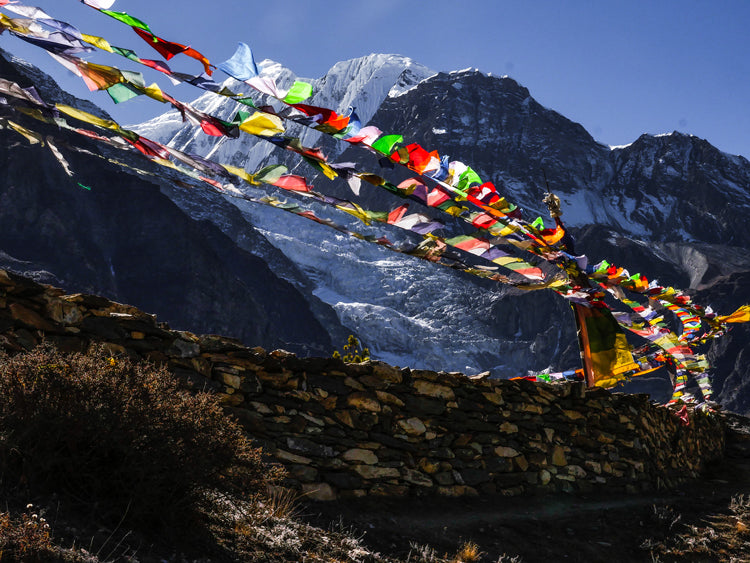
Tibetan Flag: Interesting Facts About Buddhist Prayer Flag
From the city up to the mountains, you would find one thing in common during a tour to Nepal: the Tibetan Prayer Flags flapping in rhythm with the wind. These Tibetan prayer flags, which are also called Buddhist prayer flags, are something that’s definitely going to catch your attention while climbing in the Himalayas.

No, they are not there just for decoration; these Tibetan flags carry spiritual significance. In this blog, we will unveil some interesting facts about Tibetan Prayer flags you SHOULD know.
What Are Tibetan Prayer Flags?
Tibetan prayer flags are basically square pieces of cloth strung together on a thin string. These flags contain a set of 5 different colors: red, white, blue, yellow and green and each color signifies an element: Sky, Air, Fire, Water and Earth. In Buddhism, everything in this world is composited by these five elements where;

- Blue represents Sky
- White represents Air
- Red represents Fire
- Green represents Water
- Yellow represents Earth
These colorful Buddhist prayer flags manifest the promotion of peace and prosperity. Beyond this, on each flag, a spiritual message (mantras) is printed which promotes peace, wisdom, compassion and strength.
It is believed that the more these flags wear out due to wind, the more it extends blessings. It is also believed that as the prayer flags fade away, it means the prayers have been answered.
There is a common misconception that Tibetan prayer flags carry prayers to Gods. Rather, beliefs are that the prayers are blown by the wind to spread goodwill and compassion into all-pervading space.
According to Buddhism, life moves on and is replaced by new life and to depict this thing, Tibetans mount the new flags with the old ones together.
Types of Tibetan Prayer Flags
There are two types of Prayer flags: Horizontal Prayer Flags and Vertical Prayer Flags, where the horizontal ones are called Lung ta, meaning “Wind Horse,” and the vertical ones are called Darchog, meaning "Flagstaff."
Horizontal prayer flags (Lung ta) are square or rectangular, with their top edge being connected along a long thread. These flags are commonly hung in a diagonal line between two objects. Meanwhile, Vertical Prayer Flags (Darchor) are rectangular, with each flag attached to the poles along a vertical line.

Among these two prayer flags, the Horizontal ones are the most commonly used Tibetan prayer flags. Beliefs are that as the wind passes over the Lung ta flags, the air is purified and sanctified by the mantras written on it.

Traditional prayer flags feature a Lung ta (powerful horse) bearing three flaming “ratnas” (special jewels) that symbolize Lord Buddha, Dharma (Buddhist teachings), and Sangha (Buddhist community). Writings on the flags also include mantras from three great Buddhist Bodhisattvas: Padmasambhava, Avalokiteśvara and Manjusri.
When and Where Should You Hang Prayer Flags?
According to Tibetan belief, symbols and mantras on the prayer flags are sacred and they should be treated respectfully. Tibetan flags should not be placed on the ground but should be hung high above the roof. You should consider hanging the Tibetan prayer flags outside where they can be swayed and blown by the wind. When the flags fade away and become old, they should be burned down.

If you ask when you should hang prayer flags, it is believed that prayer flags should be hung on good and auspicious days. Avoid hanging prayer flags on inauspicious astrological dates as it is deemed to bring negative results for as long as they are hung.
Below are listed the auspicious dates to hang prayer flags with the reason why they are favorable days:

You can also use the Tibetan calendar to see the assigned combination of two elements. The combination of earth and earth is believed to be the most auspicious. FYI, In Tibet, prayer flags are renewed annually on the Tibetan New Year.
Wrapping Up
Prayer flags are primarily found in Nepal but as people travel internationally, they witness the beauty of these prayer flags popping up in unfamiliar places. You can even see these prayer flags flapping free off private balconies and storefronts in the United States.
Buddhist flags may not be used for the original religious purposes but they are still a tribute to nature and peace and represent a spirit of harmony. If you want these prayer flags flying off your balcony, NepaCrafts can help you get one. We are the sole distributor of Tibetan prayer flags in the United States.
Frequently asked Questions (FAQs)
Q: What is the Meaning of Prayer Flags?
A: As its name suggests, Prayer flags carry prayers as they are blown by the wind. There are two types of Prayer flags: horizontal prayer flags which are called Lung ta, meaning “Wind Horse,” and vertical prayer flags which are called Darchog, meaning "Flagstaff."
Q: Is it ok to Hang Tibetan Prayer Flags?
A: Tibetan prayer flags carry spiritual messages that bring compassion and goodwill all over the space. Tibetan flags are not necessarily only used for religious purposes but anyone can hang these prayer flags outside.
Q: Are Prayer Flags Cultural Appropriation?
A: Yes, it is true that prayer flags originally stem from the rampant appropriation of Buddhist practices but as they are a tribute to nature and peace, representing a spirit of harmony, they can be used by anyone.
Q: In Which Religion do They Fly Prayer Flags?
A: Prayer flags are associated with Buddhism religion. According to Buddhist legends, prayer flags were first used by Gautama Buddha, on whose teachings the Buddhism religion was founded.
Q: What do Prayer Flags Symbols Represent?
A: Prayer flags feature a Lung ta (powerful horse) bearing three flaming “ratnas” (special jewels) that symbolize Lord Buddha, Dharma (Buddhist teachings), and Sangha (Buddhist community).
Q: What are Tibetan Prayer Flags Used for?
A: Tibetan Prayer Flags are used to promote peace, compassion, strength, and wisdom as they carry prayers and mantras through the wind.
Q: Tibetan Prayer Flags Colors Order?
A: Tibetan prayer flags contain 5 different colors, in order, Red, White, Blue, Yellow and Green, and these colors signify elements, Sky, Air, Fire, Water and Earth, respectively.
Q: How to Hang Prayer Flags?
A: It is considered disrespectful if the prayer flags touch the ground. So, they should always be hung at a height. Prayer flags are commonly hung in a diagonal line between two objects.

Leave a comment